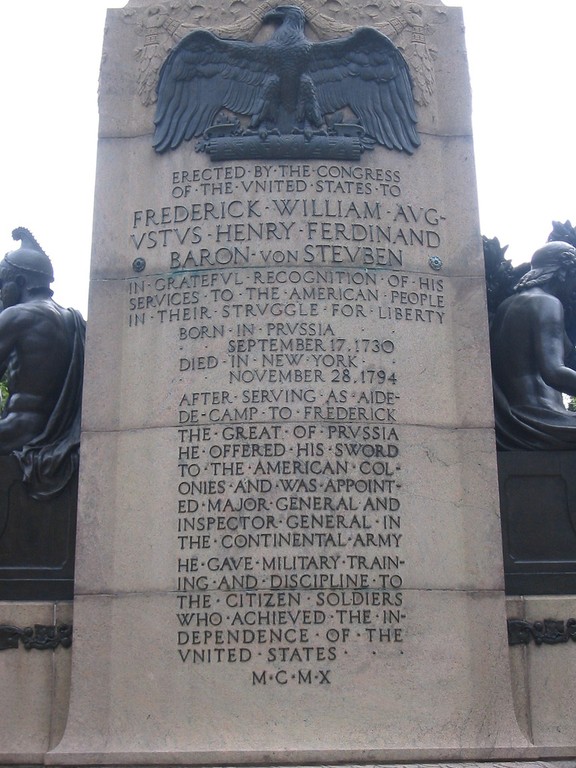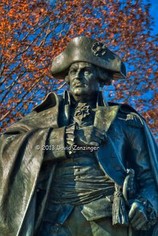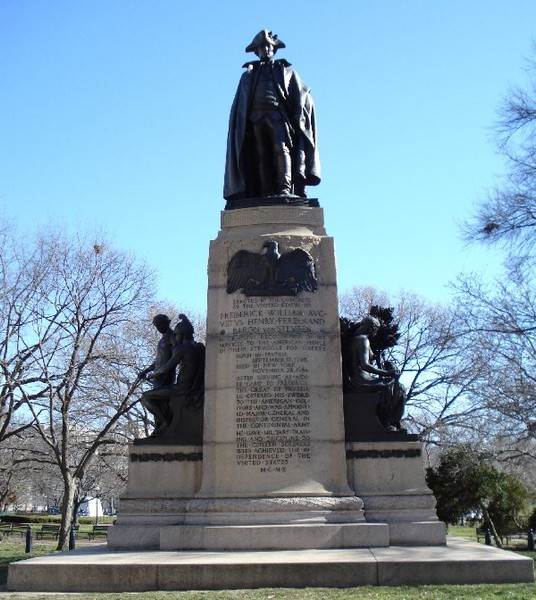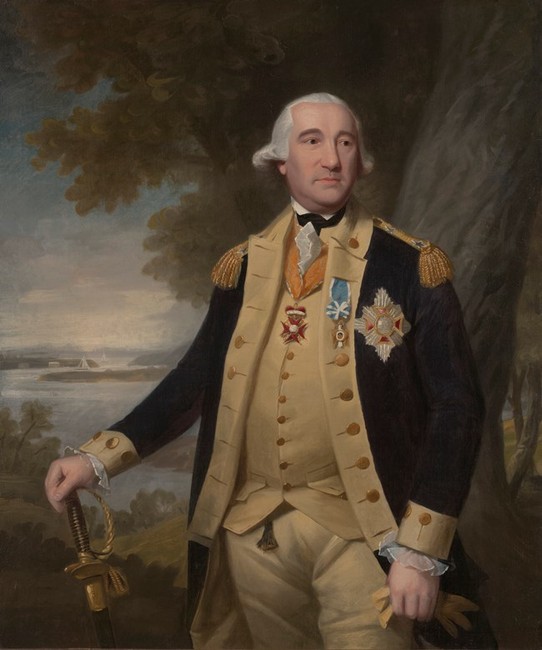Baron von Steuben Statue, Washington DC
Introduction
Text-to-speech Audio
Images
The rear of the monument includes a tribute to von Steuben.

A closer look at the Prussian military leader who became an American hero

This monument recognizes the service of Baron von Steuben who helped train and lead American soldiers in the Revolutionary War.

Portrait of Major General Friedrich Wilhelm Augustus, Baron von Steuben.

Backstory and Context
Text-to-speech Audio
Friedrich Wilhelm von Steuben was a member of a military family and the son of an engineer and lieutenant in the Prussian military. Prussia was a large state within Germany and was home to one of the world’s finest militaries. After spending his youth in Russia, von Steuben moved back to Germany with his father when he was ten years old. Full of ambition and military blood, von Steuben reached the rank of officer in the Prussian military by the time he was seventeen years old.
The Seven Years War, beginning in 1756, provided von Steuben a springboard into military stardom through the trials of an officer in a powerful army. Early in the war, von Steuben showed great promise but was wounded. During his service he gave all of himself in any endeavor that entrenched his station, a trait that would serve him well throughout his epic career as an officer in different armies. After being wounded von Steuben was granted the position of staff officer and quartermaster, providing him with immense knowledge of military leadership operations and strategic field management. Eventually, von Steuben earned favor from Frederick the Great and furthered his unique education in the complexities of leadership.
At the age of thirty-three, von Steuben was discharged from the Prussian military for reasons that are still unknown. His patronage to the soon to be French Minister of War, Louis de St. Germain, helped him earn the title of Baron and in a few years served as his connection to the fledgling Continental Army in the American Colonies. In 1777, Baron von Steuben met with Benjamin Franklin in Paris to discuss employment in the American military. Franklin saw the promise of the renowned Baron and sent him to the Colonies with a letter of recommendation for Congressional approval. Upon the genesis of his service to the Continental Army, von Steuben acted as a volunteer officer due to the lack of funds within the new government. Within a few short weeks, he was reporting directly to Washington and training rebel soldiers at Valley Forge.
Baron von Steuben quickly earned the favor of General Washington and the men within the army. Although he could not speak English, his French was good enough that he was able to communicate with some men in the army. The Baron sheltered a powerful personality, and when he arrived,
“one soldier's first impression of the Baron was ‘of the ancient fabled God of War… he seemed to me a perfect personification of Mars. The trappings of his horse, the enormous holsters of his pistols, his large size, and his strikingly martial aspect, all seemed to favor the idea."
The army was willing to listen to this martial eminence and he trained men by working with one company, about a hundred men, at a time. This company then went to teach other troops which allowed the training to spread quickly throughout. The teachings of von Steuben went beyond corralling the unruly army, however. He also taught the military how to properly encamp themselves and effectively communicate between ranks. His teachings were forever bound within his book, Regulations for the Order and Discipline of the Troops of the United States, otherwise known as the “Blue Book”. Some of the fundamental regulations within the book like uniforms, cleanliness, general orders, and accountability remain at the core of the United States Army today.
The importance of Baron von Steuben’s training program was evident in the small victories at Barren Hill and Monmouth Courthouse during the Spring of 1778. While these battles were not grand or decisive, both resulting in relative stalemates, the Continental Army found a uniformity to stack up against their British counterparts and once again saw the strength of their resolve. After his successful training at Valley Forge, Baron von Steuben moved South to aide Nathaniel Greene. During the Southern campaign of the war, the Baron served as a training and supply officer. His efforts along with those of the French reinforcements helped Greene surge to sweeping victories across the South and the eventual surrender of the British at Yorktown in 1781. In thanks for his service to the American cause, the Pennsylvania legislature extended citizenship to von Steuben in 1784 after he was given an honorable discharge from the military. Until the time of his death on November 28, 1794, Friedrich Wilhelm von Steuben remained an ally to the nation he helped free from the reaches of tyranny. He never was a rich man, but his wealth of military knowledge helped form the United States. His likeness is now eternally portrayed in Lafayette Square, just to the north of the White House. Upon the statue’s dedication in 1910, sitting President Taft said,
“We dedicate today the last of the monuments which fill the four corners of this beautiful square and which testify to the gratitude of the American people to those from France, from Poland and from Prussia who aided them in their struggle for national independence.”
In a city of monuments and great stone buildings, Baron von Steuben and his martial legacy is eternalized in the capitol that his efforts help establish.
Sources
1.Historic Valley Forge: Baron von Steuben, UShistory.org. Accessed March 21st 2020. https://www.ushistory.org/valleyforge/served/steuben.html.
2. Shay, Brian M. After 230 years, the 'Blue Book' still guides NCOs, US Army. November 2nd 2009. Accessed March 21st 2020. https://www.army.mil/article/29717/after_230_years_the_blue_book_still_guides_ncos.
3.General von Steuben, National Parks Service. August 5th 2019. Accessed March 21st 2020. https://www.nps.gov/vafo/learn/historyculture/vonsteuben.htm.
4. DC Preservation League. Accessed March 22nd 2020. https://historicsites.dcpreservation.org/items/show/572.
5.Milzarski, Eric. 7 regulations from von Steuben's 'Blue Book' that troops still follow, We Are the Mighty. September 24th 2018. Accessed March 22nd 2020. https://www.wearethemighty.com/military-culture/von-steuben-blue-book?rebelltitem=6#rebelltitem6.
Yale University Art Gallery
